Simon Faithfull- Escape Vehicle no.6
Simon Faithfull- 30 km (2004)
These two short film by Simon Faithfull show the the footage of the camera, attached to a weather balloon and set free to the edge of the space. In 'Vehicle no.6', the camera shows the journey of the domestic chair, while the second film, '30 km' is 'objectless', but framed in this circular frame. Both of the films are becoming very strange at the moment when the camera is reaching the space edge, the image is not clear, the sound becomes broken, and in the rare moments of clearness of the picture the viewer can see the outlines of the earth and the darkness of the space. the mixture of these 'ingredients' create a truly surreal experience for the viewer, when it is so easy to imagine yourself sitting on that chair and flying off to the atmosphere. There is certainly something very strange about such a simple object, a chair, to be seen in such an unusual environment. It almost breaks all the odds: a chair, something so stable, something that was built to celebrate the gravity, something meant for relaxation, being so distressed and brought 'out of a comfort zone' into the exploration of the new.
very inspiring.




















